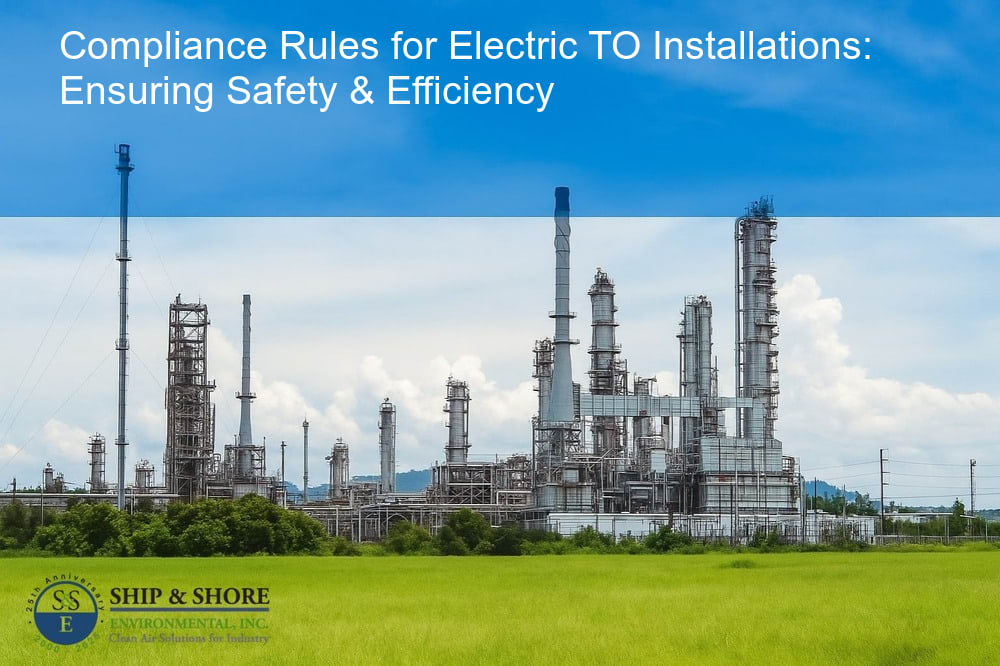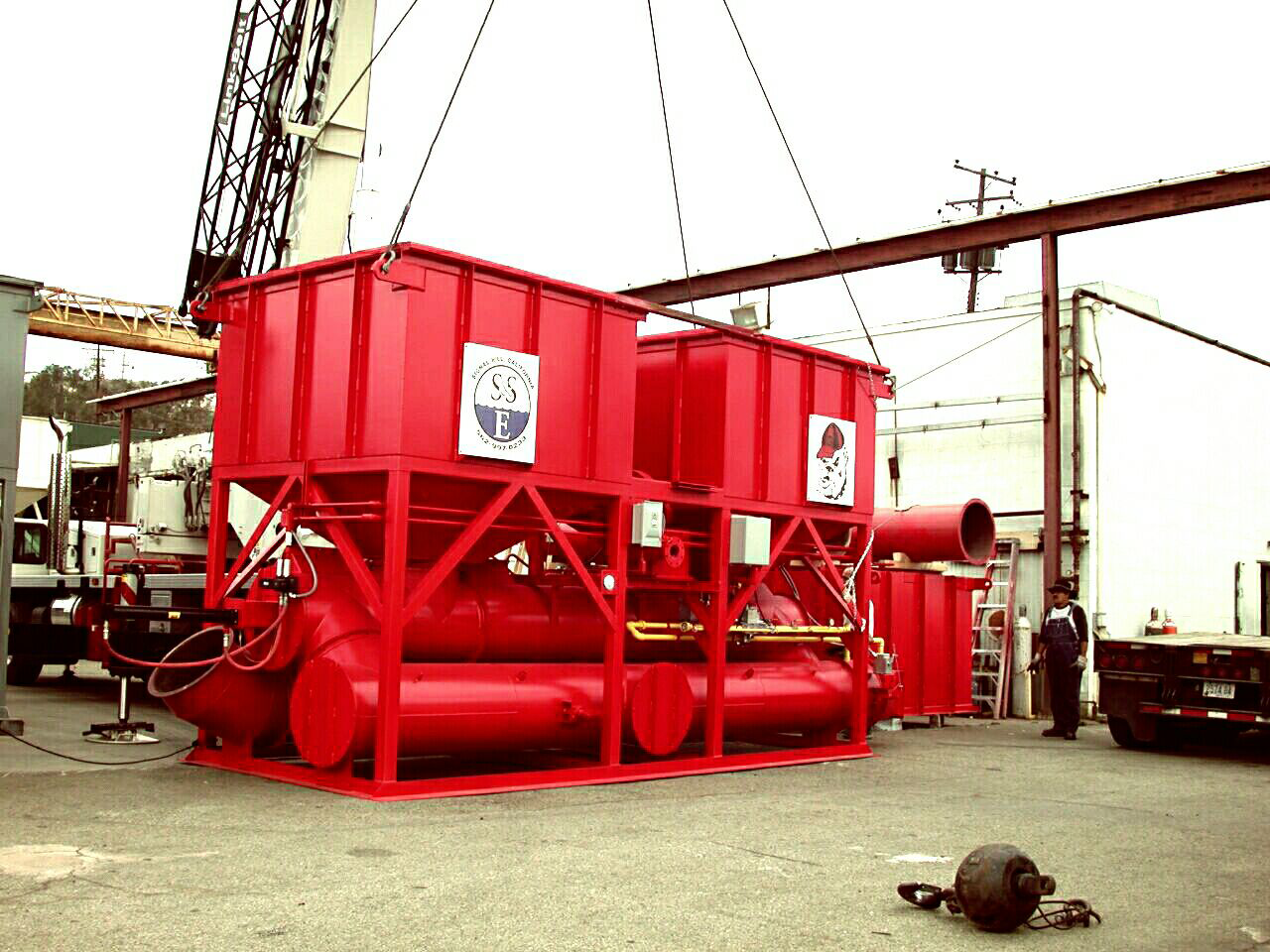
Navigating Compliance Rules for Electric TO Installations Safely
July 21, 2025 5:13 amUnderstanding the Importance of Compliance Rules for Electric Thermal Oxidizer (TO) Installations
Compliance rules for electric TO installations are paramount in ensuring that such systems operate safely and efficiently. Electric Thermal Oxidizers (TOs) play a crucial role in controlling and eliminating hazardous pollutants emitted from various industrial processes. By adhering to stringent compliance rules, we can prevent accidents, malfunctions, and non-compliance penalties, which can be costly and detrimental to both our operations and the environment. At Ship & Shore Environmental, Inc., we recognize that staying abreast of these regulations is essential for optimizing our operations and maintaining a good standing with regulatory bodies.
Brief Introduction to Electric TO Installations
Electric Thermal Oxidizers are sophisticated air pollution control devices that use electricity to generate the heat necessary for the combustion of volatile organic compounds (VOCs) and other hazardous air pollutants (HAPs). These systems are considered more environmentally friendly compared to their fossil fuel counterparts due to their ability to operate with lower emissions. Implementing electric TOs in various industries, from automotive to chemical manufacturing, demonstrates our commitment to producing cleaner, more efficient processes. However, the effectiveness of these installations heavily depends on strict adherence to compliance rules.
Legal and Safety Requirements of Electrical TO Installations
Meeting legal and safety requirements is a fundamental aspect of operating electric TO installations. Various regulations, codes, and standards must be followed to ensure that the systems are installed, maintained, and operated in a manner that minimizes potential risks. Key regulations include those set forth by OSHA (Occupational Safety and Health Administration), EPA (Environmental Protection Agency), and NFPA (National Fire Protection Association). Compliance with these rules is essential to mitigating safety hazards such as electrical faults, fire risks, and toxic emissions, thereby protecting both our workforce and the surrounding community.
Deep Dive into the Compliance Rules for Electric TO Installations
Adhering to the compliance rules for electric TO installations is crucial for ensuring both operational safety and regulatory acceptance. First and foremost, these rules encompass a gamut of guidelines set by national and local authorities, which are designed to facilitate the safe use and efficient performance of electric thermal oxidizers. Various installation aspects, including electrical wiring, control systems, and emission standards, are governed by specific parameters.
Hence, proper documentation and a thorough understanding of these rules pave the way for efficient project execution. It’s critical to note that these compliance regulations are regularly updated to reflect advancements in technology and emerging safety insights. Consequently, staying abreast of these changes is vital for companies aiming to remain compliant and competitive.
The Key Role of Regulation Compliance in Enhancing Safety and Efficacy of Electric TO Installations
Compliance rules for electric TO installations serve as the backbone for creating a secure and effective operational environment. Not only do these regulations reduce the risk of hazardous incidents, but they also fortify the structural integrity of the installation itself. For example, adhering to electrical standards minimizes the risk of faults that could result in fires or equipment malfunctions.
A structured approach to compliance can result in:
- Enhanced equipment lifespan
- Improved operational efficiency
- Mitigated risk of accidents
- Reduced downtime and maintenance costs
Transporting this framework into daily operations ensures a resilient setup, capable of withstanding various operational challenges. Moreover, by strictly following compliance guidelines, companies can avoid costly fines and legal ramifications, thereby safeguarding their financial and reputational assets.
Case Studies: Consequences of Non-Compliance in Electric TO Installations
Examining real-world instances of non-compliance offers invaluable insights into the potential repercussions. One notable case involved a mid-sized manufacturing facility that overlooked essential wiring standards. As a result, a minor electrical fault spiraled into a catastrophic fire, causing extensive property damage and halting operations for several months. This incident underscores the necessity of adhering to compliance rules for electric TO installations.
Another case study highlights a different facet of non-compliance. A company neglected emission control standards, leading to regulatory penalties and a stern directive to cease operations until compliance was achieved. The immediate financial impact was substantial and had long-term implications for the company’s reputation and stakeholder relationships.
These examples unequivocally illustrate the crucial role that compliance plays not only in preventing incidents but also in maintaining business continuity. Through a committed approach to adhering to regulations, organizations can avoid these costly setbacks and sustain a trajectory of steady, secure growth.
Did you know that non-compliance in electric thermal oxidizer installations can lead to severe legal consequences, compromising both safety and operational efficiency?
The Future of Electric TO Installations: Staying Compliant Amid Technology Advancements
As we explore the horizon of electric thermal oxidizer (TO) installations, it’s clear that the interplay between rising technological advancements and stringent compliance requirements will shape the future. Emerging technologies promise enhanced efficiencies and capabilities, yet they also introduce complexities that necessitate a vigilant adherence to compliance rules for electric TO installations. Staying ahead means not only adopting cutting-edge solutions but also ensuring that these advancements align with established legal and safety benchmarks.
Empowering Your Business Through Compliance of Electric TO Installations
Compliance is often perceived as merely a box-ticking exercise, but in reality, it serves as a robust framework that ensures operational excellence and mitigates risks. For businesses leveraging electric TO installations, embracing compliance rules reinforces trust with stakeholders, enhances the credibility of operations, and can even open doors to new business opportunities. Complying with these rules is not just about avoiding penalties; it’s about demonstrating a commitment to safety, sustainability, and efficiency.
Final Thoughts: The Interconnection between Compliance Rules, Safety, and Efficiency in Electric TO Installations
The journey towards efficient and safe electric TO installations is paved with rigorous adherence to compliance rules. Our experience and case studies evidence the tangible benefits of compliance. Safety and efficiency are not mutually exclusive objectives; rather, they are inherently tied to compliance. When we follow these rules diligently, we not only protect our workforce and assets but also enhance the overall operational efficiency.
The landscape of electric TO installations is evolving, but our commitment to compliance must remain steadfast. By aligning our operations with compliance rules for electric TO installations, we empower our business to thrive sustainably and safely in a competitive market.
FAQ
How does technological advancement impact compliance rules for electric thermal oxidizer installations?
Technological advancements have the potential to improve electric thermal oxidizer installations by making them more efficient and effective. However, as technology evolves, compliance rules are also updated to ensure that these systems are safe and environmentally friendly. Thus, we must remain vigilant, proactively adapting our practices to align with the latest regulatory changes and safety standards.
In what ways can staying compliant with regulations benefit my business?
Staying compliant can benefit your business beyond merely adhering to the law. It bolsters the trust of stakeholders, clients, and the wider community. Compliance enhances your company’s reputation for safety and reliability, fosters a responsible corporate image, and can also lead to operational efficiencies. Furthermore, it could enable access to new markets and business opportunities by meeting diverse regulatory requirements.
What are some potential risks of non-compliance with electric TO installation regulations?
Non-compliance with electric thermal oxidizer installation regulations can lead to serious risks, including hefty fines, legal action, and operational shutdowns. Additionally, there are substantial safety hazards that can result in accidents and harm to personnel and the environment. Non-compliance can also severely damage your business’s reputation, which could have long-term financial implications.
How can I ensure that my electric TO installations remain compliant with current and future regulations?
To ensure compliance, regularly review regulatory updates, invest in continuous training for your staff, and conduct periodic audits of your electric TO installations. Embrace a proactive approach by consulting with experts and engaging in industry forums to stay ahead of evolving standards. Furthermore, consider leveraging advanced compliance management systems to streamline adherence to regulations.
What role does compliance play in the operational efficiency of electric TO installations?
Compliance plays a critical role in the operational efficiency of electric TO installations. By adhering to the rules, your installations are less likely to experience downtime due to regulatory issues, resulting in uninterrupted operations. Moreover, compliance ensures that the systems work within designed parameters, promoting optimal performance and energy efficiency, which in turn reduces operational costs and environmental impact.
Categorised in: Blog

